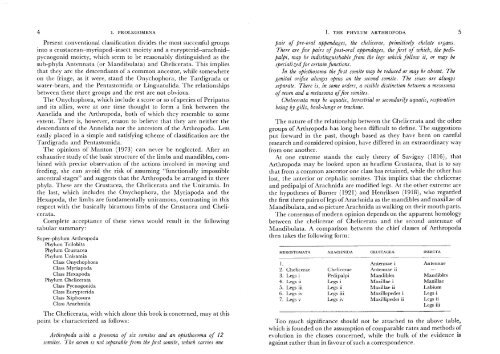Create successful ePaper yourself
Turn your PDF publications into a flip-book with our unique Google optimized e-Paper software.
4 1. PROLEGOMENA<br />
Present conventional classification divides the most successful groups<br />
into a crustacean-myriapod-insect moiety and a eurypterid-arachnidpycnogonid<br />
moiety, which seem to be reasonably distinguished as the<br />
sub-phyla Antennata (or Mandibulata) and Chelicerata. This implies<br />
that they arc the descendants of a common ancestor, while somewhere<br />
on the fringe, as it were, stand the Onychophora, the Tardigrada or<br />
water-bears, and the Pentastomida or Linguatulida. The relationships<br />
between these three groups and the rest are not obvious.<br />
The Onychophora, which include a score or so of species ofPeripatus<br />
and its allies, were at one time thought to form a link between the<br />
Annelida and the Arthropoda, both of which they resemble to some<br />
extent. There is, however, reason to believe that they are neither the<br />
descendants of the Annelida nor the ancestors of the Arthropoda. Less<br />
easily placed in a simple and satisfying scheme of classification are the<br />
Tardigrada and Pentastomida.<br />
The opinions of Man ton ( 1973) can never be neglected. After an<br />
exhaustive study of the basic structure of the limbs and mandibles, combined<br />
with precise observation of the actions involved in moving and<br />
feeding, she can avoid the risk of assuming "functionally impossible<br />
ancestral stages" and suggests that the Arthropoda be arranged in three<br />
phyla. These are the Crustacea, the Chelicerata and the U niramia. In<br />
the last, which includes the Onychophora, the Myriapoda and the<br />
Hexapoda, the limbs are fundamentally uniramous, contrasting in this<br />
respect with the basically biramous limbs of the Crustacea and Chelicerata.<br />
Complete acceptance of these views would result in the following<br />
tabular summary:<br />
Super-phylum Arthropoda<br />
Phylum Trilobita<br />
Phylum Crustacea<br />
Phylum Uniramia<br />
Class Onychophora<br />
Class Myriapoda<br />
Class Hexapoda<br />
Phylum Chelicerata<br />
Class Pycnogonida<br />
Class Eurypterida<br />
Class Xiphosura<br />
Class <strong>Arachnida</strong><br />
The Chelicerata, with which alone this book is concerned, may at this<br />
point be characterized as follows:<br />
Arthropoda with a prosoma of six somites and an opisthosoma of 12<br />
somites. The acron is not separable from the first somite, which carries one<br />
l. THE PHYLUM ARTHROPODA<br />
pair of pre-oml appendages, the chelicerae, primitively chelate organs.<br />
There are Jive pairs of post-oral appendages, the first of which, the pedipalpi,<br />
may be indistinguishable from the legs which follow it, or may be<br />
specialized for certain Junctions.<br />
In the opisthosoma the first somite may be reduced or may be absent. The<br />
genital orifice always opens on the second somite. The sexes are always<br />
separate. There is, in some orders, a visible distinction between a mesosoma<br />
of seven and a metasoma of five somites.<br />
Chelicemta may be aquatic, terrestrial or secondarily aquatic, respiration<br />
being by gills, book-lungs or tracheae.<br />
The nature of the relationship between the Chelicerata and the other<br />
groups of Arthropoda has long been difficult to define. The suggestions<br />
put forward in the past, though based as they have been on careful<br />
research and considered opinion, have differed in an extraordinary way<br />
from one another.<br />
At one extreme stands the early theory of Savigny ( 1816), that<br />
Arthropoda may be looked upon as headless Crustacea, that is to say<br />
that from a common ancestor one class has retained, while the other has<br />
lost, the anterior or cephalic somites. This implies that the chelicerae<br />
and pedipalpi of <strong>Arachnida</strong> are modified legs. At the other extreme are<br />
the hypotheses of Borner ( 1921) and Henriksen ( 1918), who regarded<br />
the first three pairs oflegs of <strong>Arachnida</strong> as the mandibles and maxillae of<br />
Mandibulata, and so picture <strong>Arachnida</strong> as walking on their mouth parts.<br />
The consensus of modern opinion depends on the apparent homology<br />
between the chelicerae of Chelicerata and the second antennae of<br />
Mandibulata. A comparison between the chief classes of Arthropoda<br />
then takes the following form:<br />
MEROSTOMATA ARACHNIDA CRUSTACEA INSECTA<br />
I. Antennae i Antennae<br />
2. Chelicerae Chelicerae Antennae ii<br />
3. Legs i Pedipalpi Mandibles Mandibles<br />
4. Legs ii Legs i Maxillae i Maxillae<br />
5. Legs iii Legs ii Maxillae ii Labium<br />
6. Legs iv Legs iii Maxillepedes i Legs i<br />
7. Legs v Legs iv Maxillipedes ii Legs ii<br />
Legs iii<br />
Too much significance should not be attached to the above table,<br />
which is founded on the assumption of comparable rates and methods of<br />
evolution in the classes concerned, while the bulk of the evidence is<br />
against rather than in favour of such a correspondence.<br />
5















